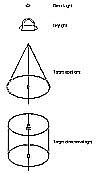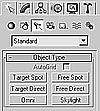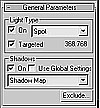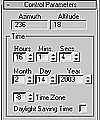Creating Lights
As in nature, illumination in 3ds max is the product of a complex interaction of lights and objects. To participate, lights and objects must be placed so that there is a direct line of sight between them, and objects must be renderable.
3ds max 5 offers four basic types of lights (Figure 11.5):
Omni light—Radiates light in all directions from a single source point.
Skylight—Simulates diffuse outdoor lighting from the dome of the sky.
Spotlight (target and free)—Illuminates an area within a cone, similar to a stage light. Target spotlights point at a target that you aim. Free spotlights have no target, so they can be maneuvered more easily.
Directional light (target and free)—Like spotlights, directional lights use a cone of illumination, except that the cone sides are parallel. This is because directional lights have parallel rays, while spotlights spread light from a single source point.
 Figure
11.5 The basic light types. Free spotlights and free directional lights look
the same as their targeted counterparts, minus the target box.
Figure
11.5 The basic light types. Free spotlights and free directional lights look
the same as their targeted counterparts, minus the target box.
You create basic lights in the Lights branch of the Create panel (Figure 11.6).
 Figure
11.6 The Lights branch of the Create panel.
Figure
11.6 The Lights branch of the Create panel.
In addition to the basic light types, there are two types of lighting systems that you create in the Systems branch of the Create panel:
Sunlight system—A hybrid light source that combines a free directional light with a Compass object to simulate the position of the sun as it moves across the sky over time.
Daylight system—A hybrid light source that combines the direct light of the sun with the scattered light of the sky to produce realistic outdoor lighting that changes over time. Daylight systems use an advanced type of lighting called photometric lights by default (see sidebar).
By default, shadow casting is turned off for basic lights and turned on for lighting systems. Ambient light, the diffuse background light of a scene that fills in shadow areas, is turned off by default.
When you start building a scene in 3ds max, the default lighting has no direction. No matter which viewport you look in, the light appears brightest on the sides of the objects that face you. This lighting configuration was designed to make modeling easier, as the object facing you in the middle of the viewport is always fully lit.
There is a second default lighting configuration that places two omni lights along a diagonal through the world origin, from top-left-front to below-right-back. This lighting is more realistic and interesting.
Photometric Lights
Photometric lights simulate realistic lighting based on physical measurements of light intensity. 3ds max offers eight types of photometric lights: target point lights, free point lights, target linear lights, free linear lights, target area lights, free area lights, IES skylights, and IES sunlights. For more information on photometric lights and their settings, see the 3ds max 5 User Reference.
Lighting requires a bit of finesse. To make the process easier, you will start by creating a practice scene, and then add lights to it until the scene is fully illuminated.
To create a practice scene:
-
Rotate the Perspective view so that the grid is parallel to the edges of the viewport (Figure 11.7).
-
In the Perspective viewport, create some light-colored objects and place them near the origin. Then place a white plane underneath (Figure 11.8).
-
The light colors of the objects will make it easier to see the effects of light.
-
With the Perspective viewport still active, open the Viewport Configuration dialog box by right-clicking a viewport label and choosing Configure, or right-clicking any viewport control button.
-
In the Rendering Method tab panel, check Default Lighting and select 2 Lights (Figure 11.9). Then click OK.
-
Change the Perspective viewport to an ActiveShade viewport by choosing ActiveShade Viewport in the Rendering menu, or by right clicking the viewport label and choosing ActiveShade under Views.
-
In the Front viewport, zoom out and pan so you will have plenty of room to place lights around the scene.
-
Choose File > Save, and name your scene Practice.max.
-
Choose File > Save As, and name your scene Practice00.max. This will serve as a back up copy in case you accidentally save over your scene.
 Figure
11.7 When you build a scene on a grid that is grid parallel to the viewport,
it makes it easier to position lights around it.
Figure
11.7 When you build a scene on a grid that is grid parallel to the viewport,
it makes it easier to position lights around it.
 Figure
11.8 The practice scene consists of light-colored objects.
Figure
11.8 The practice scene consists of light-colored objects.
 Figure
11.9 This setting creates two default lights that you can later add to the
scene from the Views menu.
Figure
11.9 This setting creates two default lights that you can later add to the
scene from the Views menu.
The ActiveShade viewport renders the scene (Figure 11.10).
 Figure
11.10 The ActiveShade viewport renders the new default lighting.
Figure
11.10 The ActiveShade viewport renders the new default lighting.
As you do geometry objects, you create light objects by clicking and dragging. As soon as you create a light, the default lighting is turned off and the new light illuminates the scene.
A common way of lighting scenes is to use a bright key light for primary illumination of a scene, and one or more fill lights to make the dark edges of forms more discernable.
In the next three exercises, you'll create a spotlight and an omni light for your key light and a fill light, and then add a direct light to serve as an accent light.
To create a target spotlight:
-
Open Practice.max.
-
In the Create panel, open the Lights sub-panel.
-
In the Object Type rollout, click Target Spotlight.
-
In the Front viewport, click in the upper-left corner to create the spotlight. Then drag to the center of the scene to create the target and aim the light (Figure 11.11).
-
In the General Parameters rollout, enable Shadows (Figure 11.13).
-
The viewport is redrawn. Shadows appear in the ActiveShade viewport and in rendered views (Figure 11.14).
-
Save the scene as Practice01.max.
The spotlight illuminates the objects within its cone. The default lights are turned off (Figure 11.12).
 Figure
11.11 A target spotlight has a source, a cone of illumination, and a target.
Figure
11.11 A target spotlight has a source, a cone of illumination, and a target.
 Figure 11.12 The cone of
illumination delimits the pool of light.
Figure 11.12 The cone of
illumination delimits the pool of light.
The objects cast shadows. If the ActiveShade viewport does not show the shadows, right-click in the viewport and choose Initialize from the Tools quad menu.
 Figure
11.13 After enabling shadows for the spotlight.
Figure
11.13 After enabling shadows for the spotlight.
 Figure
11.14 The objects cast shadows based on the position of the source.
Figure
11.14 The objects cast shadows based on the position of the source.
There are many parameters you can adjust on a light, but the settings that you usually adjust right away are the intensity, color, position, and aim. Additional light settings are explained in the sections on shadow casting and controlling illumination.
To adjust a target spotlight:
-
Open Practice01.max.
-
Select the spotlight.
-
Open the Modify panel.
-
In the Intensity/Color/Attenuation rollout, increase the Multiplier to 1.25, or just enough to brighten the scene without washing it out (Figure 11.15).
-
In the Intensity/Color/Attenuation rollout, click the white color swatch.
-
In the Color Selector: Light Color dialog box, select a color using the Hue and Whiteness sliders, or type in the RGB or HSV amounts (Figure 11.16).
-
In the Top viewport, select and move the light so that it is about 30- in front of the scene (Figure 11.17).
-
Right-click on the light and choose Select Target from the Tools 1 quad menu.
-
Move the target to the origin. You can do this easily by right-clicking the X, Y, and Z spinners of the Transform Type-in boxes on the status bar, while in Absolute mode.
-
Render your scene to see the result (Figure 11.18).
-
Adjust the light further until you are satisfied. Then save your scene.
 Figure
11.16 Selecting a color for the light.
Figure
11.16 Selecting a color for the light.
 Figure
11.17 After positioning the light to the front of the scene.
Figure
11.17 After positioning the light to the front of the scene.
 Figure
11.18 After repositioning the light and its target.
Figure
11.18 After repositioning the light and its target.
Omni lights have only a single component. Similar to a bare light bulb, they are the simplest lights to create and adjust.
To create an omni light:
-
Open Practice01.max.
-
In the Create panel, open the Lights sub-panel.
-
In the Object Type rollout, click Omni.
-
In the Front viewport, click in the lower-right corner to create the omni light (Figure 11.19).
-
In either the Top or Left viewport, move the omni light slightly in back of the scene so it is opposite the spotlight (Figure 11.21).
-
In the Intensity/Color/Attenuation rollout, reduce the Multiplier of the light to around .5, or just enough to dimly illuminate the dark sides of the objects.
-
Render the scene to see the result (Figure 11.22).
-
Save the scene as Practice02.max.
 Figure
11.19 After creating the omni light in the Front viewport.
Figure
11.19 After creating the omni light in the Front viewport.
The objects in the scene are lit from below and to the right. The plane does not block the light because its surface normals face away from the light (Figure 11.20).
 Figure
11.20 The scene is now lit from below right by the fill light.
Figure
11.20 The scene is now lit from below right by the fill light.
 Figure
11.21 After moving the omni light into position.
Figure
11.21 After moving the omni light into position.
 Figure
11.22 The key light and fill light illuminate the objects from the front
left and back right.
Figure
11.22 The key light and fill light illuminate the objects from the front
left and back right.
TIP
Click the plus sign "+" next to the Save button in the Save File As dialog box to increment your file by +01.
If you add the two default lights in Practice.max to the scene they will turn into omni lights named DefaultKeyLight and DefaultFillLight. Once added, you can adjust them like other omni lights. To do so, choose Views > Add Default Lights to Scene. Note that the single default light cannot be added to a scene.
Free lights are aimed without using a target. This makes them easier to transform and animate.
Free spotlights and directional lights are created with a single click. The light is automatically aimed at the grid of the viewport in which you clicked (a.k.a. the construction grid).
To create a free directional light:
-
Open Practice02.max.
-
In the Create panel, open the Lights sub-panel.
-
In the Object Type rollout, click Free Direct.
-
In the Top viewport, click on top of an object that you would like to highlight.
-
In the Front or Left viewport, move the directional light above the object.
-
In the Intensity/Color/Attenuation rollout, reduce the Multiplier so that it doesn't bleach out the object. Try a setting of around .5.
-
In the General Parameters rollout, check On to enable shadow casting.
-
Open the Modify panel. Then select the spotlight and reduce its intensity multiplier to around 1.1.
-
Render the scene to see the result (Figure 11.25).
-
Save the scene as Practice03.max.
The free directional light appears in the viewport on top of the object (Figure 11.23).
 Figure
11.23 Place the free directional light directly over an object.
Figure
11.23 Place the free directional light directly over an object.
The light singles out the object with additional illumination (Figure 11.24).
 Figure
11.24 When you first set the directional light, it may be too bright.
Figure
11.24 When you first set the directional light, it may be too bright.
 Figure
11.25 After adjusting the lights and turning on cast shadows.
Figure
11.25 After adjusting the lights and turning on cast shadows.
Tip
Decreasing a Multiplier setting to a negative value causes a light to remove illumination from a scene.
A skylight acts as a dome of light to create the illusion of outdoor lighting. No matter where you place a skylight, it always illuminates the scene from above.
To create a skylight:
-
Open Practice.max.
-
In the Create panel, open the Lights sub-panel.
-
In the Object Type rollout, click Skylight.
-
Click in any viewport.
-
Choose Rendering > Advanced Lighting from the menu bar.
-
In the Advanced Lighting dialog box, open the drop-down menu and choose Light Tracer.
-
To make the scene more realistic, choose Render > Environment and change the Environment Background color to light gray.
-
Click the ActiveShade viewport to activate it.
-
From the Main toolbar, choose Quick Render (Production).
-
Save as Practice04.max.
The skylight appears in the viewport (Figure 11.26).
 Figure
11.26 Placing a skylight in the scene.
Figure
11.26 Placing a skylight in the scene.
The Light Tracer rollout appears and becomes active (Figure 11.27).
 Figure
11.27 The Light Tracer controls skylights.
Figure
11.27 The Light Tracer controls skylights.
The scene renders line by line. When it is done, the skylight diffusely illuminates the scene from above. Faint shadows gather below each object (Figure 11.28).
 Figure
11.28 The skylight diffusely illuminates the scene from above.
Figure
11.28 The skylight diffusely illuminates the scene from above.
A sunlight system is a combination of a free directional light and a compass rose that sets the orientation of the system. Ray-traced shadows are on by default.
To create a sunlight system:
-
Open Practice.max.
-
In the Create panel, open the Systems sub-panel.
-
In the Object Type rollout, click Sunlight. In sunlight system rollout, the time is set to the time on your computer, and the location is set to San Francisco, CA (Figure 11.29).
-
In the Top viewport, click and drag to create a compass rose of any size.
-
Move the cursor up or down to set the orbital distance of the sun. Then click to create the light (Figure 11.30).
-
In the Sunlight System rollout, set the time, date, and time zone for the light. You can also set the latitude and longitude, or pick a location by clicking Get Location (Figure 11.31).
-
Open the Directional Parameters rollout in the Modify panel, and uncheck Overshoot. Then increase the Hotspot until the cone of illumination encompasses the entire scene, so that shadows will appear throughout.
-
Click the ActiveShade viewport. Then click Quick Render (Production).
-
Save as Practice05.max.
 Figure
11.29 The sunlight system uses the time and date on your computer to position
the light.
Figure
11.29 The sunlight system uses the time and date on your computer to position
the light.
 Figure
11.30 The compass sets the direction; the light illuminates the scene.
Figure
11.30 The compass sets the direction; the light illuminates the scene.
Sunlight floods the scene. The ray- traced shadows are crisp and precise (Figure 11.32).
 Figure
11.32 Sunlight renders with sharp-edged ray traced shadows by default.
Figure
11.32 Sunlight renders with sharp-edged ray traced shadows by default.
Tip
After creating a sunlight system, you change its settings in the Motion panel.
A daylight system combines sunlight and skylight into one integrated system.
To create a daylight system:
-
Open Practice.max.
-
In the Create panel, open the Systems sub-panel.
-
In the Object Type rollout, click Daylight. The Daylight System rollout that appears looks just like a Sunlight System rollout.
-
In the Top viewport, click and drag to create a compass rose. Then move the cursor up or down and click to set the orbital distance of the daylight assembly head (Figure 11.33).
-
In the Daylight System rollout, set the time, date, and time zone for the light. You can also set the latitude and longitude, or pick a location by clicking Get Location.
-
At the bottom of the rollout, set the brightness of the sky. Choose from Clear, Partly Cloudy, or Cloudy.
-
Choose Rendering > Advanced Lighting, or press 9 on your keyboard.
-
In the Advanced Lighting dialog box, choose Light Tracer.
-
Choose Rendering > Environment. In the Environment dialog box, match the Background color to the amount of cloud cover that you set for the sky.
-
In the Exposure Control rollout, choose Automatic Exposure control from the drop-down menu. Then Activate the ActiveShade viewport, and click Render Preview (Figure 11.34).
-
Adjust the exposure as needed. Then click Quick Render (Production).
-
Save as Practice06.max.
 Figure
11.33 The compass orients the daylight assembly head to the location.
Figure
11.33 The compass orients the daylight assembly head to the location.
This positions the sun in the sky.
 Figure
11.34 You adjust exposure in the Environment dialog box.
Figure
11.34 You adjust exposure in the Environment dialog box.
Sunlight and daylight illuminate the scene (Figure 11.35).
 Figure
11.35 The final scene is illuminated with both sunlight and skylight.
Figure
11.35 The final scene is illuminated with both sunlight and skylight.